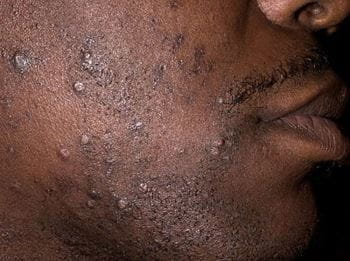Have you ever experienced the frustration of dealing with ingrown hairs in your beard? It’s not uncommon and can be quite bothersome. But don’t worry, because at BeardsDude.com, we’ve got you covered. In our upcoming article, we’ll dive deep into the topic of ingrown hairs in a beard and provide you with practical tips on how to deal with them effectively.
Ingrown hairs occur when the hair curls and grows back into the skin instead of growing outwards. This can lead to inflammation, redness, and even infection if not treated properly. We’ll discuss the causes of ingrown hairs, such as improper shaving techniques or lack of exfoliation, and explain how you can avoid them in the first place.
But what if you already have ingrown hairs in your beard? Not to worry, we’ll also share step-by-step methods on how to treat them. From gentle exfoliation techniques to using specialized products, we’ll give you the tools and knowledge to tackle those pesky ingrown hairs head-on.
So stay tuned for our upcoming article on BeardsDude.com, where you’ll learn everything you need to know to deal with ingrown hairs in your beard. It’s time to take control of your beard health and achieve the well-groomed, magnificent beard you deserve.
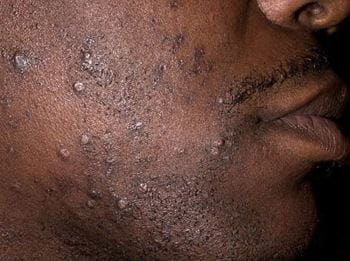
Understanding Ingrown Hairs
What are ingrown hairs?
Ingrown hairs are a common condition that occurs when a hair grows back into the skin instead of rising up from it. This can cause discomfort and irritation, particularly when it happens in the beard area. Ingrown hairs can occur in individuals of all genders and ethnicities, but they are more prevalent in those with curly or coarse hair.
The process of ingrown hair formation begins when a hair follicle becomes clogged with dead skin cells, dirt, or bacteria, preventing the hair from growing out freely. Instead, the hair curls back and continues to grow within the skin, leading to redness, swelling, and even infection in some cases.
Causes of ingrown hairs in the beard
Ingrown hairs in the beard can be caused by a variety of factors, including improper grooming techniques, tight-fitting clothing or accessories, and lack of exfoliation. Shaving against the grain and using dull razors can also increase the likelihood of ingrown hairs.
Additionally, individuals with naturally curly or coarse hair are more prone to developing ingrown hairs. This is because the curl pattern of the hair can cause it to grow back into the skin instead of growing straight out.
Common symptoms of ingrown hairs in the beard
Ingrown hairs in the beard can present with several symptoms, including:
- Redness and inflammation in the affected area
- Small, pus-filled bumps or pustules
- Itching or discomfort
- Tender or painful skin
- Darkening of the skin in the affected area
If left untreated, ingrown hairs can lead to more severe complications such as folliculitis, which is the inflammation of the hair follicles, or even abscess formation requiring medical intervention. It is important to address ingrown hairs at the earliest signs of symptoms to prevent further complications.
Prevention and Maintenance
Proper beard grooming techniques
Proper beard grooming techniques are essential for preventing ingrown hairs in the beard. Here are some tips to keep in mind:
- Trim your beard regularly to prevent the hairs from becoming too long and curling back into the skin.
- Use a sharp, clean razor when shaving. Dull razors can cause the hair to be cut unevenly, increasing the risk of ingrown hairs.
- Shave in the direction of hair growth to minimize irritation and the potential for ingrown hairs.
- Be gentle when shaving, and avoid applying excessive pressure or pulling on the skin.
- Consider using an electric razor or beard trimmer instead of a traditional razor for a more controlled and precise shave.
By following these proper grooming techniques, you can significantly reduce the likelihood of developing ingrown hairs in your beard.
Keeping the skin clean and exfoliated
Regularly cleansing and exfoliating the skin can help prevent the buildup of dead skin cells, dirt, and bacteria that can clog the hair follicles and lead to ingrown hairs. Here are some ways to keep your skin clean and exfoliated:
- Use a gentle cleanser specifically formulated for the face and beard area. Avoid harsh soaps or cleansers that can strip the skin of its natural oils.
- Gently exfoliate the skin using a mild scrub or a soft-bristled brush. This helps remove dead skin cells and stimulate blood flow to the hair follicles.
- Avoid scrubbing too vigorously, as this can irritate the skin and potentially cause more ingrown hairs.
- Rinse your face thoroughly after cleansing and exfoliating to remove any residue and ensure that the pores are clear.
By incorporating these cleansing and exfoliating practices into your skincare routine, you can maintain clean and clear skin, reducing the chances of ingrown hairs.
Using a beard brush or comb
Regularly brushing or combing your beard can help prevent ingrown hairs by promoting proper hair growth and untangling any knots or tangles. Here’s how to effectively use a beard brush or comb:
- Choose a beard brush or comb that has soft bristles or teeth to prevent scratching or damaging the skin.
- Brush or comb your beard in the direction of hair growth to detangle the hairs and encourage them to grow outward.
- Start from the roots and work your way down to the ends of the beard, ensuring that all the hairs are properly groomed.
- Be gentle and avoid pulling on the hairs too forcefully, as this can cause breakage and potential ingrown hairs.
Regularly using a beard brush or comb can help keep your beard looking neat and well-groomed, while also reducing the chances of ingrown hairs.
Avoiding tight-fitting clothing or accessories
Tight-fitting clothing or accessories, such as turtleneck sweaters, collared shirts, or scarves, can rub against the beard area and cause friction. This can lead to irritation and ingrown hairs. To prevent this:
- Opt for loose-fitting clothing and avoid garments that constantly rub against the beard area.
- If you need to wear a collar or scarf, make sure it is not too tight and does not constantly brush against the beard.
- Choose fabrics that are soft and breathable to minimize irritation.
By avoiding tight-fitting clothing or accessories, you can reduce the friction and irritation that can lead to ingrown hairs.
Moisturizing the beard and skin
Proper hydration is essential for maintaining healthy skin and preventing ingrown hairs. Here’s how to effectively moisturize your beard and skin:
- Use a moisturizing beard oil or balm specifically formulated for beard care. These products help hydrate the skin and soften the beard hairs, making them less likely to become ingrown.
- Apply the beard oil or balm daily, focusing on the root of the hairs and the skin underneath.
- Massage the product into the beard and skin to ensure proper absorption and distribution.
- Avoid using heavy or greasy products that can clog the hair follicles and increase the risk of ingrown hairs.
By keeping your beard and skin adequately moisturized, you can prevent dryness and promote healthy hair growth, reducing the chances of ingrown hairs.
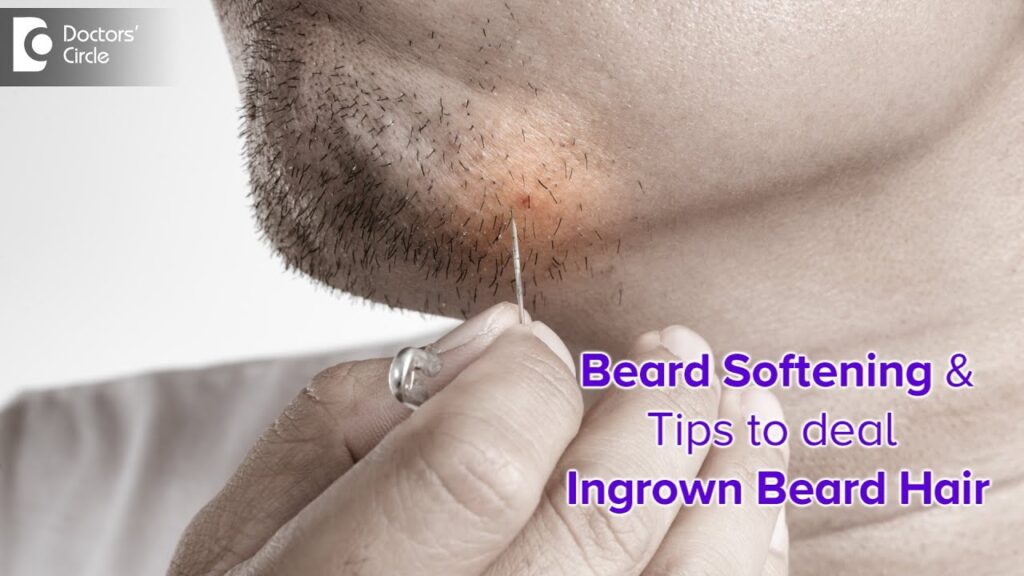
Treating Ingrown Hairs
Identifying and locating ingrown hairs
Before treating ingrown hairs, it is important to identify and locate them. Here’s how to do it:
- Carefully examine the affected area of the beard and look for small, red bumps or pustules.
- Gently palpate the area to locate any trapped hairs beneath the skin.
- Use a clean magnifying mirror if necessary to get a closer look at the ingrown hairs.
Once you have identified and located the ingrown hairs, you can proceed with the treatment.
Using a warm compress to soften the skin
Applying a warm compress to the affected area can help soften the skin, making it easier to release the trapped hair. Here’s how to use a warm compress:
- Soak a clean washcloth or towel in warm water.
- Wring out the excess water and place the warm compress on the ingrown hair.
- Hold the compress in place for 5-10 minutes, allowing the warmth to penetrate the skin.
The warm compress helps to open up the pores and soften the skin, making it easier to extract the ingrown hair.
Gently exfoliating to free the trapped hair
After using the warm compress, gently exfoliate the area to further loosen the trapped hair. Here’s how to do it:
- Use a mild exfoliating scrub or a soft-bristled brush to gently massage the affected area.
- Be careful not to apply too much pressure or scrub too vigorously, as this can further irritate the skin.
- Continue to exfoliate for a few minutes, focusing on the ingrown hair.
Gentle exfoliation helps to remove dead skin cells and other debris, freeing the trapped hair and reducing inflammation.
Using a clean and sharp needle to release the hair
If the ingrown hair remains trapped after exfoliation, you may need to use a clean and sharp needle to carefully release it. Here’s how to do it safely:
- Sterilize the needle by soaking it in rubbing alcohol for a few minutes.
- Gently puncture the surface of the skin above the ingrown hair with the sterilized needle.
- Create a small opening to allow the trapped hair to come out.
- Be very careful and precise to avoid injuring the skin or causing further damage.
Using a sterile needle can help safely release the trapped hair, allowing it to grow out of the skin.
Applying an antibacterial cream or lotion
After releasing the trapped hair, it is crucial to apply an antibacterial cream or lotion to prevent infection and further inflammation. Here’s how to do it:
- Choose an antibacterial cream or lotion specifically formulated for the face and beard area.
- Apply a small amount to the affected area and gently massage it into the skin.
- Make sure to cover the entire area surrounding the previously ingrown hair.
The antibacterial cream or lotion helps to keep the area clean and reduce the risk of infection.
Avoiding picking or squeezing the ingrown hair
Although it may be tempting, it is important to avoid picking or squeezing the ingrown hair. This can lead to further trauma to the skin and potentially cause infection. Instead, follow the aforementioned steps to safely release the ingrown hair and apply the necessary treatments.
Home Remedies for Ingrown Hairs
Tea tree oil
Tea tree oil has natural antibacterial and anti-inflammatory properties, making it an effective home remedy for ingrown hairs. Here’s how to use it:
- Dilute a few drops of tea tree oil in a carrier oil, such as coconut oil or jojoba oil.
- Apply the diluted tea tree oil to the ingrown hair and the surrounding area.
- Gently massage it into the skin and let it sit for 10-15 minutes.
- Rinse off with lukewarm water and pat dry.
Repeat this process twice daily until the ingrown hair clears up.
Aloe vera gel
Aloe vera gel is known for its soothing and healing properties, which can help reduce inflammation and promote healing of the ingrown hair. Here’s how to use it:
- Extract fresh aloe vera gel from an aloe vera leaf or use store-bought gel.
- Apply the gel directly to the ingrown hair and the surrounding area.
- Gently massage it into the skin until fully absorbed.
- Leave it on for at least 30 minutes or overnight for maximum benefits.
Repeat this process twice daily until the ingrown hair improves.
Apple cider vinegar
Apple cider vinegar has antimicrobial properties that can help prevent infection and inflammation associated with ingrown hairs. Here’s how to use it:
- Mix equal parts of raw, unfiltered apple cider vinegar and water.
- Soak a cotton ball or pad in the diluted apple cider vinegar.
- Apply the soaked cotton ball to the ingrown hair and hold it in place for a few minutes.
- Rinse off with lukewarm water and pat dry.
Repeat this process twice daily until the ingrown hair resolves.
Witch hazel
Witch hazel is a natural astringent that can help reduce inflammation and soothe the skin affected by ingrown hairs. Here’s how to use it:
- Soak a cotton ball or pad in witch hazel.
- Apply the soaked cotton ball to the ingrown hair and hold it in place for a few minutes.
- Gently massage the witch hazel into the skin using circular motions.
- Let it air dry and avoid rinsing off.
Repeat this process twice daily until the ingrown hair improves.
Coconut oil
Coconut oil is known for its moisturizing and antibacterial properties, which can help reduce inflammation and keep the skin hydrated while treating ingrown hairs. Here’s how to use it:
- Apply a small amount of organic, cold-pressed coconut oil to the ingrown hair and the surrounding area.
- Massage it into the skin until fully absorbed.
- Leave it on overnight for maximum benefits.
- Rinse off with lukewarm water and pat dry.
Repeat this process daily until the ingrown hair clears up.
Honey and cinnamon paste
Honey and cinnamon have antimicrobial and anti-inflammatory properties that can help soothe the skin and reduce inflammation caused by ingrown hairs. Here’s how to use them:
- Mix equal parts of raw honey and ground cinnamon to form a paste.
- Apply the paste to the ingrown hair and the surrounding area.
- Leave it on for 15-20 minutes.
- Rinse off with lukewarm water and pat dry.
Repeat this process twice weekly until the ingrown hair improves.
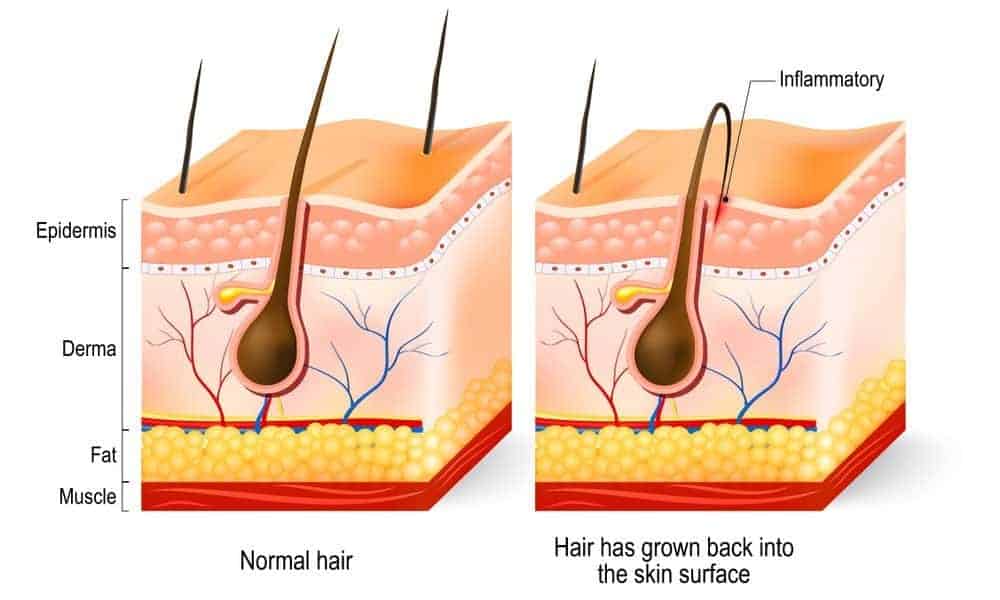
Professional Treatment Options
Consulting a dermatologist
If home remedies and self-care methods do not effectively treat ingrown hairs, it is recommended to consult a dermatologist. A dermatologist can provide professional guidance and expertise, as well as prescribe medications or treatments tailored to your specific needs.
Prescription medications for severe cases
In severe cases of ingrown hairs, a dermatologist may prescribe topical or oral medications to reduce inflammation, prevent infection, and promote healing. These medications may include topical antibiotics, corticosteroids, or retinoids.
Laser hair removal
Laser hair removal is a long-term solution for ingrown hairs. The laser targets the hair follicles, preventing future hair growth and reducing the chances of ingrown hairs. Multiple sessions may be required for optimal results.
Chemical peels
Chemical peels can effectively exfoliate the skin and unclog the hair follicles, reducing the risk of ingrown hairs. This treatment involves the application of a chemical solution to the skin, which causes the top layer to peel off, revealing new, smoother skin.
Microdermabrasion
Microdermabrasion is a non-invasive procedure that uses a handheld device to exfoliate the surface of the skin. It helps remove dead skin cells, unclog the pores, and stimulate collagen production, reducing the risk of ingrown hairs.
Tips for Preventing Ingrown Hairs
Avoiding frequent shaving
Frequent shaving can increase the risk of ingrown hairs, as the hair is cut at a sharper angle and has a higher chance of growing back into the skin. Consider allowing your beard to grow out or shaving less frequently to minimize the occurrence of ingrown hairs.
Using a sharp and clean razor
Using a sharp and clean razor is crucial for preventing ingrown hairs. Dull razors can cause uneven cutting and lead to ingrown hairs. Replace your razor regularly and ensure it is clean before each use to minimize the risk of ingrown hairs.
Shaving in the direction of hair growth
Shaving in the direction of hair growth is a key technique for preventing ingrown hairs. Shaving against the grain can cause the hair to be cut too short, increasing the likelihood of ingrown hairs. Always shave in the direction of hair growth to minimize irritation and ingrown hairs.
Exfoliating before shaving
Exfoliating the skin before shaving can help remove dead skin cells and debris that can clog the hair follicles and lead to ingrown hairs. Use a mild scrub or a soft-bristled brush to gently exfoliate the skin before shaving.
Applying a moisturizing aftershave
After shaving, apply a moisturizing aftershave to soothe the skin and keep it hydrated. Look for aftershaves that contain natural ingredients such as aloe vera or chamomile, which can help reduce inflammation and prevent irritation.

Maintaining a Healthy Beard
Regular trimming
Regularly trimming your beard helps maintain a neat and well-groomed appearance, while also minimizing the risk of ingrown hairs. Use sharp, clean scissors or a trimmer to trim your beard regularly, keeping it at a length that suits your desired style.
Using beard oil and balms
Beard oil and balms are essential for maintaining a healthy beard. These products help moisturize the skin and soften the beard hairs, making them less likely to become ingrown. Apply a small amount of beard oil or balm daily, focusing on the root of the hairs and the skin underneath.
Keeping the beard clean
Regularly washing your beard is crucial for maintaining its hygiene and preventing the buildup of dirt, bacteria, and dead skin cells that can contribute to ingrown hairs. Use a gentle cleanser specifically formulated for the face and beard area to keep your beard clean and fresh.
Avoiding harsh chemicals
Avoid using harsh chemicals, such as harsh shampoos or cleansers, on your beard. These can strip the skin and hair of their natural oils, leading to dryness, irritation, and potentially, ingrown hairs. Opt for natural, gentle products that are specifically formulated for beard care.
Eating a balanced diet
A balanced diet plays a significant role in the health of your beard. Ensure that your diet includes a variety of fruits, vegetables, lean proteins, and healthy fats to provide the essential nutrients necessary for optimal beard growth and health. Stay well-hydrated by drinking plenty of water throughout the day.
Handling Beard Itchiness
Identifying the causes of itchiness
Beard itchiness can be caused by several factors, including dry skin, irritation from shaving or grooming, and the accumulation of dead skin cells and bacteria. Identifying the underlying cause is important for effectively treating and managing beard itchiness.
Using a beard shampoo and conditioner
Using a beard shampoo and conditioner that are specifically formulated for the beard area can help alleviate itchiness by keeping the hair and skin hydrated. Look for products that contain moisturizing ingredients such as argan oil, jojoba oil, or shea butter.
Applying a soothing beard oil or balm
Beard oils and balms can help soothe and hydrate the skin, alleviating itchiness. Apply a small amount of beard oil or balm daily, focusing on the root of the hairs and the skin underneath. Massage it into the beard and skin to ensure proper absorption.
Avoiding excessive scratching
Although it may be tempting, it is important to avoid excessive scratching of the beard, as this can further irritate the skin and potentially lead to ingrown hairs or infections. Instead, use a beard comb or brush to gently untangle any knots or tangles.
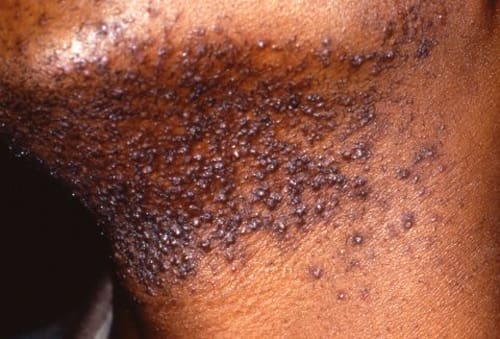
Dealing with Beard Dandruff
Understanding the causes of beard dandruff
Beard dandruff, also known as beardruff, is a common condition characterized by the presence of dry, flaky skin in the beard area. It is often caused by the same factors that contribute to scalp dandruff, such as dry skin, fungal infections, or excessive oil production.
Using a medicated dandruff shampoo
If you are experiencing beard dandruff, using a medicated dandruff shampoo can help alleviate the symptoms. Look for shampoos that contain active ingredients such as ketoconazole, selenium sulfide, or zinc pyrithione, which help control fungal growth and reduce flaking.
Applying a moisturizing beard oil or balm
Moisturizing the beard and skin is essential for preventing and managing beard dandruff. Apply a moisturizing beard oil or balm daily, focusing on the root of the hairs and the skin underneath. Massage it into the beard and skin to ensure proper absorption.
Regularly exfoliating the skin
Regularly exfoliating the skin helps remove dead skin cells and prevent the buildup of flakes in the beard area. Use a mild exfoliating scrub or a soft-bristled brush to gently massage the skin in circular motions. Be gentle and avoid over-exfoliating, as this can irritate the skin.
Maintaining Beard Hygiene
Washing the beard regularly
Regularly washing your beard is essential for maintaining its hygiene and preventing the buildup of dirt, bacteria, and dead skin cells. Use a gentle cleanser specifically formulated for the face and beard area to keep your beard clean and fresh.
Using a gentle cleanser
Avoid using harsh soaps or cleansers on your beard, as these can strip the skin and hair of their natural oils, leading to dryness and irritation. Opt for gentle cleansers that are specifically formulated for the face and beard area to maintain the health of your beard.
Drying the beard properly
After washing your beard, make sure to dry it properly. Gently pat the beard with a clean towel to remove excess moisture, taking care not to rub or tug on the hairs. Avoid using heat styling tools such as hairdryers, as they can further dry out the beard and cause damage.
Avoiding sharing beard grooming tools
To maintain good beard hygiene, avoid sharing your beard grooming tools with others. Sharing brushes, combs, or razors can transfer bacteria, fungi, and other microorganisms that can lead to infections or skin conditions.
Keeping the beard and face moisturized
Proper hydration is key to maintaining the health of your beard and preventing dryness and irritation. Apply a moisturizing beard oil or balm daily, focusing on the root of the hairs and the skin underneath. Massage it into the beard and skin to ensure proper absorption.
The Psychological Impact of Ingrown Hairs
Effects on self-esteem and confidence
Ingrown hairs can have a negative impact on self-esteem and confidence. The visible redness, bumps, and discomfort associated with ingrown hairs can make individuals feel self-conscious about their appearance, leading to a decrease in confidence and self-esteem.
Social interactions and perceptions
Ingrown hairs can also affect social interactions and how others perceive individuals. The visible signs of ingrown hairs can lead to assumptions about personal hygiene or grooming habits, creating unnecessary judgment or discomfort in social situations.
Finding support and understanding
Finding support and understanding is crucial for individuals dealing with the psychological impact of ingrown hairs. Connecting with others who have experienced similar issues can help create a sense of empathy and reassurance. Sharing experiences, tips, and advice can also provide insights and strategies for managing the emotional aspects of ingrown hairs.
Conclusion
Dealing with ingrown hairs in a beard can be frustrating and uncomfortable. However, with proper prevention, maintenance, and treatment, the risk of ingrown hairs can be significantly reduced. By following the tips and techniques outlined in this article, you can take control of your beard health and confidently embrace the art of growing and maintaining a beard. Remember, everyone’s beard journey is unique, and by finding what works best for you, you can enjoy a healthy, well-groomed beard that showcases your personal style and confidence.
